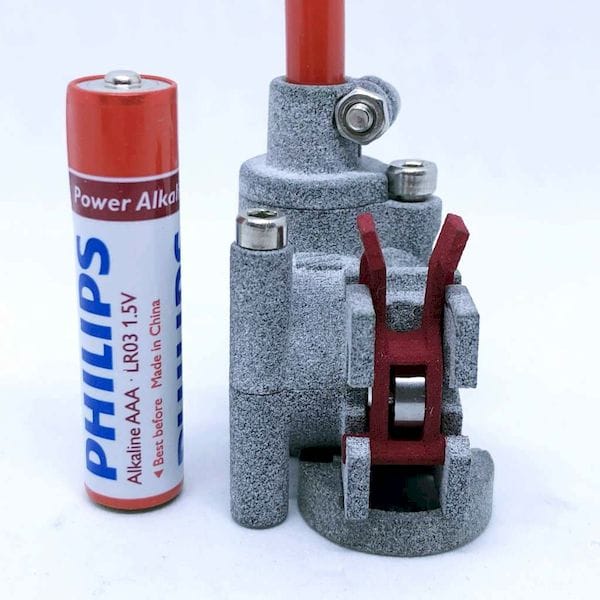![The lightweight Nimble extruder [Source: Zesty Technology]](https://fabbaloo.com/wp-content/uploads/2020/05/image-asset_img_5eb099ae0017f.jpg)
I’m looking at a unique 3D printer extruder design from Zesty called “Nimble”.
Cyprus-based Zesty Technology produces this unusual design that is neither a direct or bowden-style extruder, but something else entirely.
Readers may be familiar with the two major styles of extruder for filament-based 3D printers, direct and bowden. If not, please check our explanation of the two here.
Direct drive is perhaps more popular, and involves placing the stepper motor directly on top of the hot end, so that the filament is pushed only a few millimeters before it enters the hot zone and begins softening. The advantage is that there is little opportunity for the filament to stretch, tangle, or otherwise foul up during printing. The disadvantage is that the weight of the stepper motor makes the moving portion of the system quite heavy, limiting its ability to react to fast changes in direction.
Bowden-style devices involve placing the stepper motor outside the build chamber, where they push the filament along a long path through a tube to the hot end. The advantage is that the moving portion of the hot end is lightweight and thus can, at least in theory, be operated at higher speeds. However, slack space in the tube and natural elasticity in the filament can make retraction operations challenging, and some highly flexible filaments simply cannot be attempted, as they would bung up in the bowden tube like pushing wet spaghetti.
There are proponents for both approaches, and neither is right or wrong. Direct drive systems are more popular, perhaps because they do work with any material, at least at slow speeds.
![The drive cable used on the Nimble extruder [Source: Zesty Technology]](https://fabbaloo.com/wp-content/uploads/2020/05/nimble-cable_result_img_5eb099ae4c8bf.jpg)
Zesty Technology’s Nimble extruder works like neither of these approaches. Here’s how it works:
-
The stepper motor is located outside the build volume, in a spot where you might expect to find a bowden system’s motor
-
The motor does not drive the filament as a bowden system would; instead it rotates a rigid cable
-
The rotating cable is connected to the moving portion of the extrusion system, where the rotational motion of the cable is transferred to a gear system that moves the filament
-
The component that attaches to the hot end is not only very lightweight, but it is simplified and is extremely easy to load and clean
This configuration allows the moving portion to be lightweight, as a bowden extrusion system would be, but also has a short push-length, as a direct drive system would be. It seems to have the advantages of both direct and bowden.
Zesty Technology says the gear ratio is such that there is tremendous control over the flow, perhaps enabling well-controlled retractions. However, I am interested to know how much “play” is involved in the rotational cable. If it is significant, then we might see bowden-like effects, where there is a slight delay between action and reaction at the hot end.
Nevertheless, the Nimble extruder is a revolutionary approach that merits further examination.
It is possible to purchase a Nimble extruder today, at a cost of US$95.95. However, it is only the extruder, and you’ll have to install it onto an existing filament-based 3D printer by replacing the extrusion system.
Zesty Technology provides a number of adapters suitable to fit popular desktop 3D printers through an arrangement with Shapeways, where the adapters are 3D printed in strong nylon on demand.
I’m hoping to see the Nimble extruder be licensed by 3D printer manufacturers for default installation in products to simplify things, but I’m not certain if any manufacturers have done so yet. I believe this extruder could be an important selling point for some offerings, where it could differentiate the 3D printer from the competition.
Via Zesty Technology











